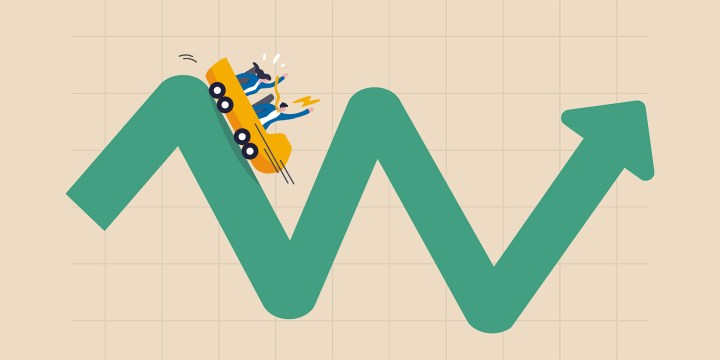AFTER THE BELL
It would be great to get back to an ordinary panic

Let’s face it, there are few things more volatile than stock markets. Every day they bounce around like springboks in a lion encampment. But this incessant movement does have one advantage: You can use it to measure how nervous people are.
Chemical engineering students sometimes have fun comparing the world’s most explosive chemicals, and that list will normally feature 1-Diazidocarbamoyl-5-azidotetrazole, which is known colloquially as azidoazide azide.
The name “azidoazide azide” is a joke of some kind, but unfortunately, having zero chemical knowledge, I have no idea why it’s funny; I think it’s because of the three, consecutive “azides” — you know, chemist humour. Or perhaps it’s the fact that it’s so volatile, you really need to stand azide.
And when I say “very volatile”, I mean really, very volatile. When the team of US and German chemists discovered how to synthesise it in 2010, they claimed it was a “very exciting discovery”. But they did mention in the fine print that they were not able to measure its sensitivity because that was “beyond our capacities of measurement”. This was because “even the smallest possible loadings in shock-and-friction tests led to explosive decomposition”.
They did, however, create a helpful list of things that would make it explode. The list included: moving it, touching it, dispersing it in solution, exposing it to bright light, exposing it to X-rays, putting it in a spectrometer, turning on the spectrometer, and, best of all, “absolutely nothing”. I am not making this up.
Volatility, we learn from an early age, is something to fear — often correctly. Even the word volatile is often associated with substances that will blow up. Volatile is defined as something liable to change rapidly and unpredictably, especially for the worse.
Visit Daily Maverick’s home page for more news, analysis and investigations
And, let’s face it, there are few things more volatile than stock markets. Every day they bounce around like springboks in a lion encampment. They just never seem to stand still. But this incessant movement does have one advantage: you can use it to measure how nervous people are. The assumption is that the higher the volatility, the higher the nervousness.
There have been lots of attempts at creating a generally accepted measure and the one which we appear to have settled on is called the “VIX”, which is why it is included in the list below.
The VIX is the popular name for the Chicago Board Options Exchange’s CBOE Volatility Index, a popular measure of the stock market’s expectation of volatility based on S&P 500 index options. It is often referred to as the “fear index”. A level of below 10 is regarded as low, between 10 and 19 is regarded as average, and anything over that is regarded as high.
It can and does bounce around a lot; in fact, it is designed to do so in an attempt to provide us with a forward-looking indicator. The very fact that it is derived from options trading — where you bet on the future direction of shares — is part of that design.
Consequently, it can jump really, really high, very quickly. The VIX has been over 80 twice in its short history as a well-known measure: once at the height of the financial crisis in 2008; and once just as the Covid-19 pandemic broke out in 2020. But between these points, it has shot up to more than 35 six times on the back of mini-crises.
Even for the VIX, this is volatile.
One of those occasions has been very recent, as global markets were gripped by rising interest rates and its corollary, the anticipation of a big decline in global growth.
It is worth noting that the VIX has come down very quickly over the past month from around 35 to just more than 20. In other words, we may be about to enter the “normal” zone.
Interest rate battle
To me, that’s pretty remarkable. If you read the financial press, it’s still widely assumed that most countries will slide into recession sometime next year, if they are not in it already. And, in most countries, inflation is still rising faster than anticipated, including in South Africa. What, if anything, is the VIX trying to tell us?
The one thing to remember is that the VIX is attached to the S&P 500, which is the index dominated by large, American companies. They are somewhat a proxy for the global economic state, but it is a US-centric measure.
It’s also worth noting that the VIX has spent the past year bouncing between around a level of 35 and dropping down to 20, only to bounce back again.
Yet, to me at least, the current lowish level of the VIX is surprising. I think what the VIX is saying to us is that this economic downturn is centred on the interest rate battle, which means it is different in character from many other downturns.
Hence, every time it seems as though interest rates have peaked, the VIX becomes a somewhat calmer version of itself. It also incorporates the notion that because the slowdown is created essentially by central banks, it can be fixed by central banks too.
I suspect this is a very hopeful interpretation. But for the optimists out there, the VIX is currently providing some data-centric ammunition, and that is encouraging.
Of course, there may be some azidoazide azide lying about somewhere and there is a big academic argument about whether the VIX is a useful forward predictor or not. But it would be great to get back to an ordinary panic. BM/DM


















 Become an Insider
Become an Insider
Comments - Please login in order to comment.